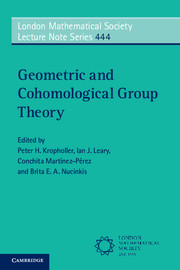Book contents
- Frontmatter
- Contents
- List of Participants
- Preface
- Obstructions for subgroups of Thompson's group V
- Groups of homological dimension one
- Braided diagram groups and local similarity groups
- On Thompson's group T and algebraic K-theory
- Special cube complexes (based on lectures of Piotr Przytycki)
- A hyperbolic group with a finitely presented subgroup that is not of type FP3
- The structure of Euclidean Artin groups
- Finitely presented groups associated with expanding maps
- On characteristic modules of groups
- Controlled algebra for simplicial rings and algebraic K-theory
- References
Braided diagram groups and local similarity groups
Published online by Cambridge University Press: 11 October 2017
- Frontmatter
- Contents
- List of Participants
- Preface
- Obstructions for subgroups of Thompson's group V
- Groups of homological dimension one
- Braided diagram groups and local similarity groups
- On Thompson's group T and algebraic K-theory
- Special cube complexes (based on lectures of Piotr Przytycki)
- A hyperbolic group with a finitely presented subgroup that is not of type FP3
- The structure of Euclidean Artin groups
- Finitely presented groups associated with expanding maps
- On characteristic modules of groups
- Controlled algebra for simplicial rings and algebraic K-theory
- References
Summary
Abstract
Hughes defined a class of groups that act as local similarities on compact ultrametric spaces. Guba and Sapir had previously defined braided diagram groups over semigroup presentations. The two classes of groups share some common characteristics: both act properly by isometries on CAT(0) cubical complexes, and certain groups in both classes have type F∞, for instance.
Here we clarify the relationship between these families of groups: the braided diagram groups over tree-like semigroup presentations are precisely the groups that act on compact ultrametric spaces via small similarity structures. The proof can be considered a generalization of the proof that Thompson's group V is a braided diagram group over a tree-like semigroup presentation.
We also prove that certain additional groups, such as the Houghton groups Hn, and QAut(T2,c), lie in both classes.
Introduction
In [7], Hughes described a class of groups that act as homeomorphisms on compact ultrametric spaces. Fix a compact ultrametric space X. The essence of the idea was to associate to X a finite similarity structure, which is a function that associates to each ordered pair of balls B1,B2 ⊆ X a finite set SimX(B1,B2) of surjective similarities from B1 to B2. (A similarity is a map that stretches or contracts distances by a fixed constant.) The finite sets SimX(B1,B2) are assumed to have certain desirable closure properties (such as closure under composition). A homeomorphism h : X → X is said to be locally determined by SimX if each x ∈ X has a ball neighborhood B with the property that h(B) is a ball and the restriction of h to B agrees with one of the local similarities σ ∈ SimX(B, h(B)). The collection of all homeomorphisms that are locally determined by SimX forms a group under composition. We will call such a group an FSS group (finite similarity structure group) for short. Hughes [7] proved that each FSS group has the Haagerup property, and even acts properly on a CAT(0) cubical complex. In [5], the authors described a class of FSS groups that have type F∞. That class includes Thompson's group V, and the main theorem of [5] is best understood as a generalization of [2], where Brown originally showed that V has type F∞.
- Type
- Chapter
- Information
- Geometric and Cohomological Group Theory , pp. 15 - 33Publisher: Cambridge University PressPrint publication year: 2017
References
- 1
- Cited by



